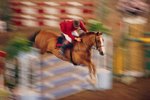If you don't have a horse's registration papers or are otherwise unsure of the animal's parentage, determining his breed consists of educated guessing. If you're familiar with the basic body types and other characteristics of well-known breeds, you can probably figure out which ones contributed to your horse's ancestry. However, even the most experienced horse people and equine vets might mistake a horse's breed if the horse in question doesn't share obvious traits of his lineage or resembles another breed entirely. For example, the Standardbred, used in harness racing, includes thoroughbred, Morgan and Hackney lines in his ancestry, and it's not unusual for an individual to "throw back" in appearance.
Horse Types
When horse folks refer to an animal as "typey," they mean he looks just like his breed. Scrutinize the horse and look for evidence of equine types.
- The stock types -- generally quarterhorses and color breeds such as paints or palominos, they are compact and muscular and built for ranch work.
- The hotbloods -- Arabians and thoroughbreds are considered refined, hot-blooded horses, and the modern thoroughbred descends from Arabian ancestry. The Arabian boasts a dished face and arched neck on one end and a tail carried high on the other. He's usually small, ranging between 14 and 15 hands high at the withers. The thoroughbred stands taller, sometimes exceeding 17 hands, and should possess a proud, athletic appearance. Thoroughbreds and thoroughbred crosses are often referred to as "hunter" types.
- The warmbloods -- these horses, originally developed in Europe, are used primarily as sport horses and excel in jumping, dressage and combined driving. They are usually large, strong and elegant animals.
- The draft horses -- true draft horses are hard to mistake for any other type, based on their sheer size and bulk. Draft horses are often crossed with lighter breeds to produce pleasure and sport horses with the strong bones of the working horse and the athletic ability of the hunter type. Profuse feathering on the legs is a sign that a horse has draft blood.
- The saddle horses -- saddle horse types, which include the American Saddlebred and the Morgan, carry their necks, heads and tails upright. They should appear especially alert and animated. The American Saddlebred is larger and usually more fine-boned than the Morgan. Some saddlebreds are gaited -- they will perform the rack and the slow gait in addition to the standard gaits of walk, trot and canter.
- The gaited breeds -- gaited horses, including the Tennessee Walker, are often identified by their movements, as they don't always trot but instead perform a smooth running walk. Other gaited horses will pace, tolt, or have another gait unique to a certain breed, such as that of the Paso Fino.
Tattoos and Brands
One of the simplest ways to determine whether a horse is of a certain breed is to check his upper lip for a tattoo, his neck for a freezebrand or other parts of the body for branding. Thoroughbreds who raced have a lip tattoo consisting of a letter followed by five numbers. Racing quarterhorses are also tattooed. Standardbreds born after 1995 have a freezebrand of five characters, a mix of letters and numbers. Those born prior to 1995 sport a lip tattoo. Mustangs gathered from federal lands also have neck freezebrands, which include their registration number and birth year. To identify a horse via a tattoo or freezebrand, contact the governing body of the breed. For example, the Jockey Club registers thoroughbreds.
Brands for Western-type horses, such as the quarterhorse, aren't as easy to identify, but state Departments of Agriculture should have the brands of various farms and ranches on file. Of course, you won't necessarily have any idea where the horse originated. Seek help from online and Facebook groups dedicated to brand identification. Warmblood breeds are often branded, with each particular breed using a specific brand that often includes a birth year or registration number.
Tips
Lack of a tattoo doesn't necessarily mean a horse isn't a thoroughbred. A horse who didn't make it to the track or wasn't bred for racing won't have a tattoo. Since thoroughbreds are commonly crossed with other breeds to add athleticism, a thoroughbred-type may be a crossbreed.
DNA Testing
While DNA testing can't determine a horse's breed per se, it can provide you with a great deal of information about the animal and can ensure that an individual horse did indeed have the particular parents advertised. Genetic disease testing lets you know if a horse is susceptible to certain hereditary disorders -- which also lets you know that a specific breed is somewhere in the horse's makeup.
Writer Bio
Jane Meggitt has been a writer for more than 20 years. In addition to reporting for a major newspaper chain, she has been published in "Horse News," "Suburban Classic," "Hoof Beats," "Equine Journal" and other publications. She has a Bachelor of Arts in English from New York University and an Associate of Arts from the American Academy of Dramatics Arts, New York City.



